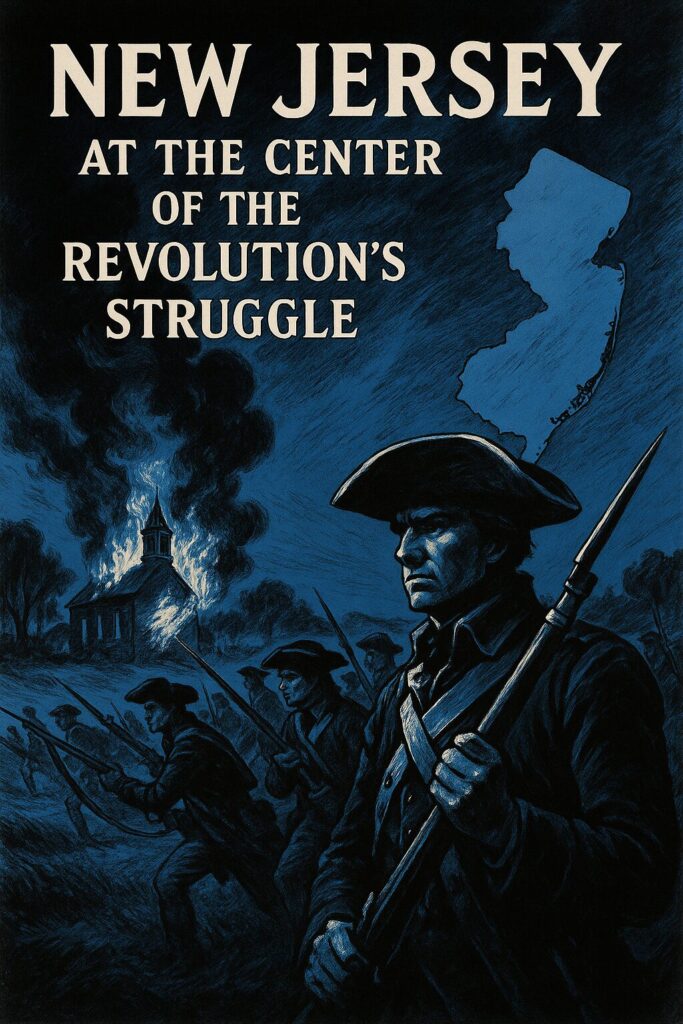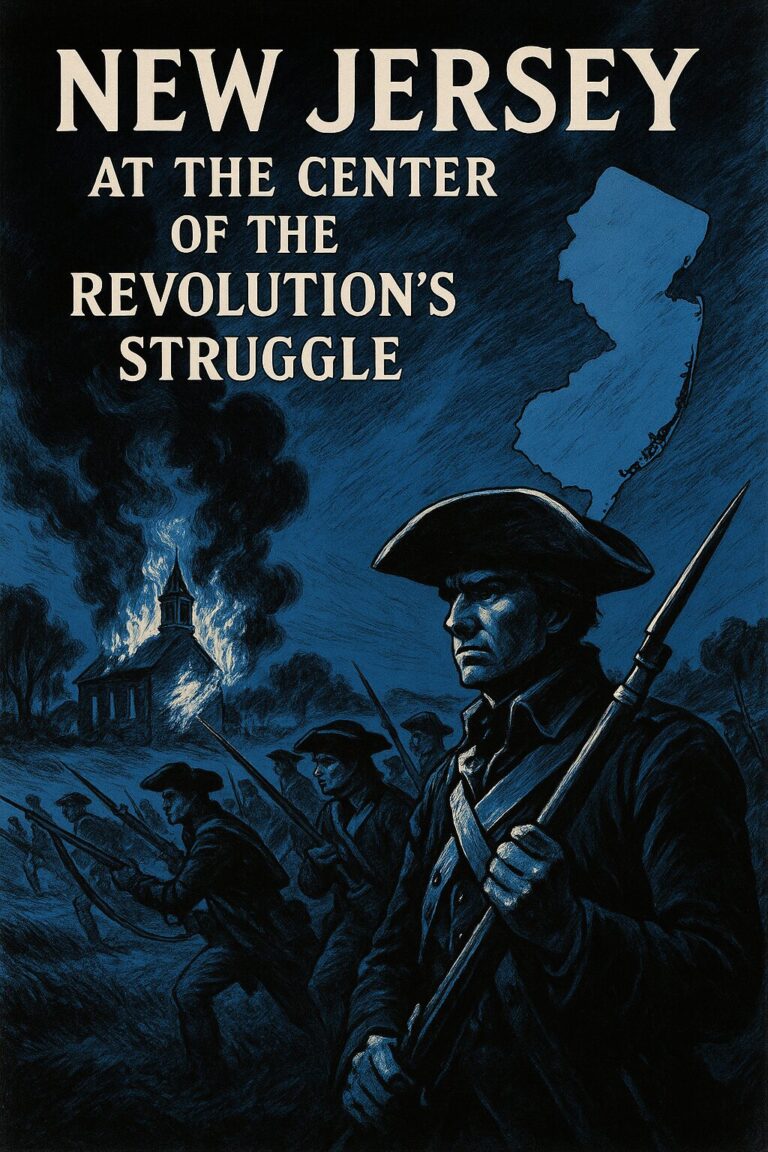
When people think of the American Revolution, their minds often leap to Boston’s tea-stained harbor or Philadelphia’s Independence Hall. But the war’s beating heart was in New Jersey — a state that saw more battles, endured longer under Washington’s command, and suffered more direct attacks on its towns and people than anywhere else in the colonies.
America’s Fiercest Revolutionary Battleground
New Jersey witnessed more Revolutionary War battles and skirmishes than any other state — over 200 documented engagements ranging from major set-piece battles to lightning-fast partisan raids. Its rivers, turnpikes, and ridgelines became familiar to both armies, traversed again and again as the war dragged on.
From the desperate winter strikes at Trenton and Princeton, to the bloody summer clash at Monmouth, to the defiant stands at Springfield and Connecticut Farms in 1780, New Jersey’s fields and streets were as much a part of the fight as any battlefield in the new nation.
Washington’s Longest Campaign in Any State
George Washington spent more time in New Jersey than anywhere else — nearly two and a half years between 1775 and 1783. Here he endured the winter of 1777 at Morristown, and the record-breaking cold of 1779–1780 at Jockey Hollow, where his army starved, froze, and still found the will to march when the alarm came.
While in New Jersey, Washington accomplished far more than battlefield leadership—he also shaped the identity, diplomacy, and resilience of the fledgling nation. In Haddonfield, he is believed to have collaborated with Francis Hopkinson, a New Jersey delegate to the Continental Congress, on early flag design concepts—most notably the six-pointed stars forming a thirteen-star constellation, linked by some historians to the “Forgotten Flag” of the Revolution. He also played a direct role in standardizing the look of the Continental Army.
In 1779, Washington approved the uniform regulations that gave New Jersey’s regiments their distinctive blue coats with buff facings, the color pairing long associated with the state and reminiscent of Washington’s own favored uniform. The “Jersey Blues” nickname dated back to the colonial era, but under Washington’s direction, these uniforms became part of a broader Continental identity—practical on the battlefield, symbolic of unity, and enduring in legacy, with buff and blue later incorporated into the New Jersey state flag. Beyond military maneuvers, Washington used his extended time in New Jersey to refine training standards with Baron Von Steuben, secure and oversee supply lines, negotiate prisoner exchanges, deal with Benedict Arnold, maintain the French alliance, coordinate his New Jersey Spy ring and coordinate with Governor William Livingston to defend the state from British incursions—particularly the campaign of destruction aimed at silencing the so-called “Presbyterian Rebellion.”
In Morristown, he hosted Lafayette, Henry Knox, and other senior leaders to plan future campaigns and integrate the incoming French army under Rochambeau. Washington’s years in New Jersey became a blend of military command, statecraft, and symbolic leadership—laying the groundwork for both the battlefield victories and the national identity of the United States.
From the Ford Mansion, Washington coordinated defenses across the state. On June 23, 1780 — the day of the Battle of Springfield — it was recorded as his last day in that house. That summer’s campaigns would be the last major British push into New Jersey.
The Presbyterian Rebellion and the Price of Defiance – The Spiritual War
For the British high command, New Jersey’s resistance wasn’t just military — it was ideological. The network of Presbyterian churches, led by figures like Reverend James Caldwell, became pulpits for liberty and abolitionism, rallying both militia and community resolve. British officers derisively called it “the Presbyterian Rebellion” and set out to destroy it.
In June 1780, that destruction became reality. Under orders shaped by Royalist ex-governors William Tryon and William Franklin, and executed by hard men like Lt. Col. John Graves Simcoe, British and Loyalist troops burned churches, homes, and whole villages. At Connecticut Farms, Hannah Caldwell — wife of Reverend Caldwell — was shot and killed in her own home. The act was no accident; Loyalist conspirators saw her death as a way to break the man and silence his pulpit.
The Revolution in New Jersey was as much a war of pulpits as it was of muskets. Anglican loyalists saw the growing network of patriot-aligned Presbyterian ministers as a direct threat to both the Crown and the Church of England‘s authority. British officers and press slandered Reverend James Caldwell as the “Rebel High Priest,” casting him as a dangerous zealot whose sermons inflamed the militia as much as any drumbeat. Reading his own words, he only reminded parishioners to be kind and respect the British soldiers, even after his own wife was killed. That does not sound like a fiery reverend, but someone who was known to be the most kind and thoughtful in all he did. He was not alone. Men like Jacob Green of Hanover—an early abolitionist voice—Alexander MacDougall, a patriot leader and fierce critic of British religious and political dominance, and Frederick Frelinghuysen, whose father was a revered Dutch Reformed minister, all carried the same reputation: ministers or sons of ministers whose faith fused with the cause of liberty.
In the eyes of British loyalists, these men were heretics in both religion and politics—proof that Presbyterian pulpits had become rebel arsenals. The British answer was to silence them by burning churches, scattering congregations, and, when possible, killing their leaders, but the spirit they sought to crush only hardened. From the pulpits of New Jersey rang a gospel of freedom, and when the smoke of battle cleared, it was the Word—not the King—that remained standing.
The Forgotten Victory of 1780
Despite the devastation, the New Jersey militia and Continental troops stood their ground. At Springfield, Greene’s and Lee’s men held key bridges at the Rahway River and Vauxhall Road, blunting the British drive toward Morristown. The Continental Army and the Militia both fought with valor that June. The cost was high — Springfield was burned almost entirely to the ground — but the line held. The Watchung Gap was impassible with the amount of weapons facing down at them. The British would never again mount a serious offensive into New Jersey.
These actions, and the many lesser-known skirmishes across the state, formed a victory not of territory gained, but of survival and endurance. They preserved Washington’s headquarters, kept the army intact, and ensured that New Jersey remained a secure base for the final campaigns of the war.
A Story Too Long Forgotten
The Forgotten Victory Trail exists to stitch these places and stories back together — from Elizabeth’s landing sites, to the Union church home where Hannah Caldwell fell, to Taylor Park in Millburn where the militia stood at the Rahway River, to Morristown and Pluckemin where the army trained and planned, to Clinton where supply lines and tavern floors still hold the memory of marching boots.
This is a New Jersey story — one of Rebel Reverends, Black Soldiers, Women of Courage, and Militia Farmers — united by a vision of liberty. It is also a story of cruelty, conspiracy, and loss, where entire communities were marked for destruction simply because they stood on the wrong side of a king.
It is a story worth telling loudly, so it is never again lost to the margins of history.

